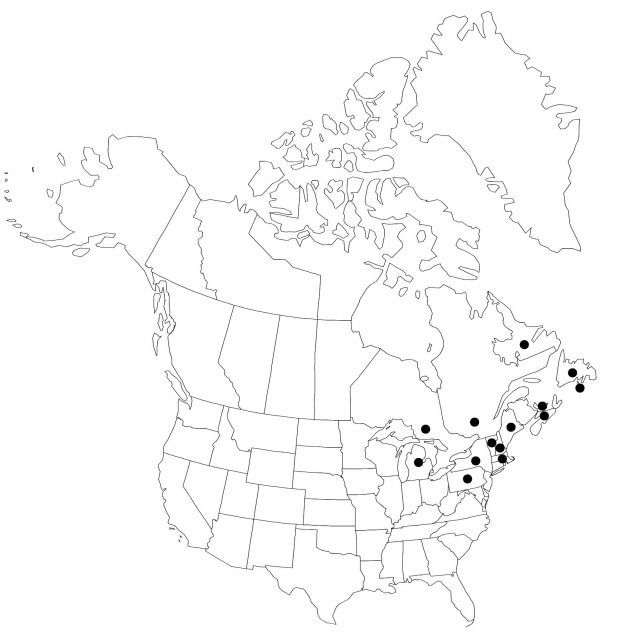Carex wiegandii
in N. L. Brittion et al., N. Amer. Fl. 18: 108. 1931.
Culms 10–105 cm. Leaves 3–8 per culm; sheaths tight, inner band hyaline, 4–23 cm, apex concave, ± glabrous; ligules rounded to obtuse, 0.9–2.5 mm; blades plicate, 11–45 cm × 1.7–5 mm, widest leaf 2.8–5 mm wide. Inflorescences (0.8–) 1.5–3 cm; spikes 4–6; lateral spikes gynecandrous, 4.5–8 mm, sessile, staminate portion (0–) 1–3-flowered, (0–) 0.5–2 mm, pistillate portion 5–21-flowered, 3–8 mm; basal 2 spikes 1.3–9.5 mm apart; terminal spike androgynous, 6.1–14.5 mm, staminate portion 5–20-flowered, 2–8.6 × 0.8–1.3 mm, pistillate portion 7–25-flowered, 3–8 × 5–7.3 mm. Pistillate scales ovate, 1.45–2 (–2.2) × 1.3–1.9 mm, apex obtuse to acute, sometimes shortly mucronate. Staminate scales ovate, 1.2–2.3 × 1.4–1.8 mm, apex obtuse to acute. Anthers 0.7–1.3 mm. Perigynia spreading to reflexed, green to castaneous, 5–18-veined abaxially, faintly 0–10-veined adaxially, broadly ovate, 2.55–3.75 × (1.25–) 1.4–2 (–2.1) mm, (1.4–) 1.6–2.5 times as long as wide; beak 0.55–1.1 (–1.35) mm, 0.25–0.55 length of body, serrulate, teeth 0.2–0.5 mm. Achenes ovate, 1.4–1.9 × 1.1–1.55 mm.
Phenology: Fruiting late spring–early summer.
Habitat: Bogs, openings in acidic conifer, mixed, or alder swamps, wet acidic sandy or peaty meadows
Elevation: 0–1300 m
Distribution

St. Pierre and Miquelon, N.S., Nfld. and Labr., N.S., Ont., P.E.I., Que., Maine, Mass., Mich., N.H., N.Y., Pa., Vt.
Discussion
A putative hybrid between Carex wiegandii and C. echinata subsp. echinata has been collected in Michigan.
Selected References
None.
Lower Taxa
"shortened" is not a number.
